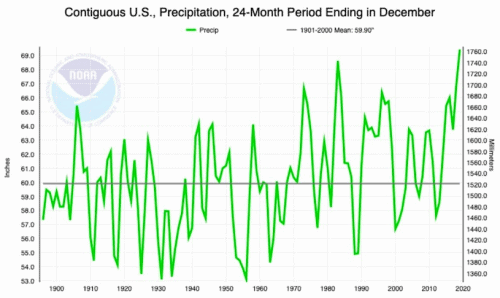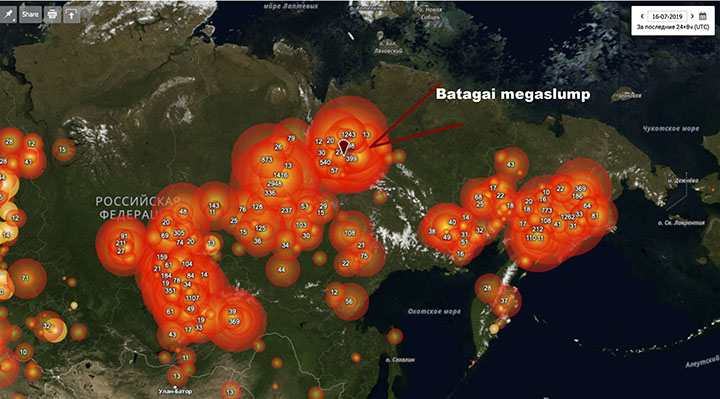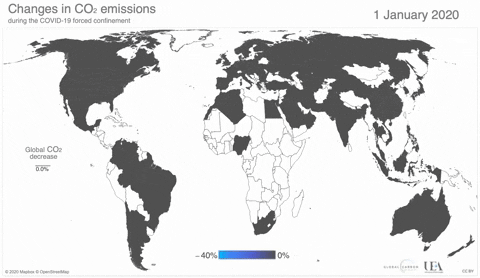Sumatra region heats up as rainforests are razed for palm oil plantations – “The land use change does not only impact biodiversity and stored carbon, but also has a surface warming effect, adding to climate change”
By Hans Nicholas Jong
29 October 2017
(Mongabay) – The wholesale destruction of rainforests across parts of Indonesia’s Sumatra island to make way for cash-crop plantations has not just devastated animal and plant biodiversity in the region, but may also be driving an alarming rise in temperatures on the ground, a new study suggests.
Average temperatures in Jambi province, one of the most heavily deforested regions in Sumatra, rose by 1.05 degrees Celsius (1.89 degrees Fahrenheit) between 2000 and 2015 — and more than half that increase can be attributed to the lack of forest cover, according to the new research published in the European Geosciences Union journal Biogeosciences.
The team of researchers from the University of Göttingen in Germany used satellite data collected between 2000 and 2015 by the NASA Landsat missions and the MODIS instrument, as well as data collected on the ground, to compare average land surface temperature increases in Jambi with a site that was covered by forest during the entire period (and thus considered to be unaffected by direct land-use change).
They found the temperature of the forest site rose by just 0.45 degrees Celsius during that period, suggesting that at least 0.6 degrees Celsius of the total 1.05 degree increase was due to land-use change.
“We see that transformed land uses have a higher land surface temperature compared to forest, particularly bare land and young oil palm plantations, explaining the observed surface temperature increase in the province,” Alexander Knohl, a professor of bioclimatology and one of the research team leaders, said in an interview.
On clear-cut land, used mainly for agriculture, the temperature could be up to 10 degrees Celsius hotter than in forests, while young and mature palm oil plantations could be up to 6 degrees and 0.8 degrees Celsius warmer, respectively. [more]
Sumatran region heats up as forests disappear
25 October 2017 (Georg-August-Universität Göttingen) – In the past decades, large areas of forest in Sumatra, Indonesia have been replaced by cash crops like oil palm plantations and rubber. Now a team of scientists led by the University of Göttingen found out that these changes in land use increase temperatures in the region. The added warming could affect plants and animals and make parts of the country more vulnerable to wildfires. The results are reported in the European Geosciences Union journal Biogeosciences.
Palm oil is the most widely used vegetable oil in the world, appearing in the ingredients’ list of many consumer goods, from chocolate to soap. Indonesia, the world’s largest producer of palm oil, has seen large swathes of rainforest cleared away and replaced by oil palm plantations. The island of Sumatra has had the highest loss of native rainforest in all of Indonesia. In the framework of the Collaborative Research Centre “Ecological and Socioeconomic Functions of Tropical Lowland Rainforest Transformation Systems (Sumatra, Indonesia)” of the University of Göttingen the research team, led by Clifton Sabajo and Alexander Knohl, now found out that the expansion of oil palm and other cash crops in Sumatra has made the region warmer.
“The land use change does not only impact biodiversity and stored carbon, but also has a surface warming effect, adding to climate change,” says Knohl, a professor in bioclimatology.
The team studied differences in surface temperature for various types of land cover, such as forests, clear-cut land, and cash crops, in the Jambi province of Sumatra. They used satellite data collected be-tween 2000 and 2015 as well as data collected on the ground. They found that clear-cut land was up to 10 degrees Celsius warmer than forests.
“Clear-cut land is the phase after forest has cleared away and before the start of commercial plantations or farming,” says Sabajo, a PhD student and the lead author of the study.Mature palm oil plantations were about 0.8 degrees Celsius warmer than forests, while young palm oil plantations were 6 degrees Celsius warmer.
“Young palm oil plantations have fewer and smaller leaves and an open canopy, thus they transpire less water. Also, the soil receives more solar radiation and dries out faster,” explains Sabajo. Mature palm oil plantations, which are older than 5 years, have a closed canopy and larger and more abundant leaves, which results in a cooler ground compared to a young plantation.
The coldest surface temperatures they found in forests mainly because of evaporative cooling, which is similar to the process that cools us down when we sweat.Overall, the average mid-morning surface temperature in the Jambi province increased by 1.05 degrees Celsius between 2000 and 2015. Some of this warming is a result of climate change, but some is a direct consequence of the changes in land use.
“We compared the average land-surface temperature increase in the province with a site that was covered by forest over the entire period and that can be considered as a control, unaffected by direct land-use change. The land-surface temperature of the forest sites only in-creased by 0.45 degrees Celsius, suggesting that at least 0.6 degrees Celsius of the 1.05 degrees Celsius increase is due to land-use change,” says Knohl.
To the scientists, the strong warming effect in the Jambi province may serve as an indication of future changes in land-surface temperature for other regions of Indonesia that will undergo land transformations towards oil palm plantations.
“Land surface temperature is an important part of the microclimate, which shapes habitat conditions for plants and animals,” says Knohl. “The observed warming may affect ecosystems in many ways. Current land-use developments in Indonesia need to carefully evaluate and consider all aspects of environmental and socio-economic consequences.”
Original paper: Sabajo, C. R., le Maire, G., June, T., Meijide, A., Roupsard, O., and Knohl, A.: Expansion of oil palm and other cash crops causes an increase of the land surface temperature in the Jambi province in Indonesia, Biogeosciences, 14, 4619–4635, https://doi.org/10.5194/bg-14-4619-2017, 2017
Contact
Prof. Dr. Alexander Knohl and Clifton Sabajo
University of Göttingen
Faculty of Forest Sciences and Forest Ecology – Bioclimatology
Büsgenweg 2, D-37077 Göttingen
Phone: +49 551 39-33682 and 39-12114
Mail: aknohl@uni-goettingen.de and csabajo@uni-goettingen.de
Web: www.uni-goettingen.de/en/67076.html
Deforestation linked to palm oil production is making Indonesia warmer
ABSTRACT: Indonesia is currently one of the regions with the highest transformation rate of land surface worldwide related to the expansion of oil palm plantations and other cash crops replacing forests on large scales. Land cover changes, which modify land surface properties, have a direct effect on the land surface temperature (LST), a key driver for many ecological functions. Despite the large historic land transformation in Indonesia toward oil palm and other cash crops and governmental plans for future expansion, this is the first study so far to quantify the impacts of land transformation on the LST in Indonesia. We analyze LST from the thermal band of a Landsat image and produce a high-resolution surface temperature map (30 m) for the lowlands of the Jambi province in Sumatra (Indonesia), a region which suffered large land transformation towards oil palm and other cash crops over the past decades. The comparison of LST, albedo, normalized differenced vegetation index (NDVI) and evapotranspiration (ET) between seven different land cover types (forest, urban areas, clear-cut land, young and mature oil palm plantations, acacia and rubber plantations) shows that forests have lower surface temperatures than the other land cover types, indicating a local warming effect after forest conversion. LST differences were up to 10.1 ± 2.6 °C (mean ± SD) between forest and clear-cut land. The differences in surface temperatures are explained by an evaporative cooling effect, which offsets the albedo warming effect. Our analysis of the LST trend of the past 16 years based on MODIS data shows that the average daytime surface temperature in the Jambi province increased by 1.05 °C, which followed the trend of observed land cover changes and exceeded the effects of climate warming. This study provides evidence that the expansion of oil palm plantations and other cash crops leads to changes in biophysical variables, warming the land surface and thus enhancing the increase of the air temperature because of climate change.


